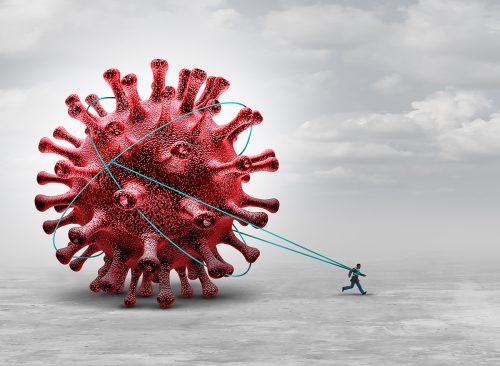New Hypermutated COVID Variant is Growing at “Unprecedented” Rate, Virus Experts Warn
A new strain is attempting to evade immunity.

Viruses live to mutate, and that always causes scientists concern, particularly when it comes to COVID-19. The original strain of COVID mutated into the Delta and Omicron variants, each more contagious than the last. Even highly mutated strains of the virus are changing, attempting to evade immunity caused by vaccines and widespread infection with previous strains. “The hyper-mutated BA.2.86 is adding mutations. Key now is JN.1, which is separating from the pack,” tweeted physician-scientist Dr. Eric Topol on Oct. 24. Read on to find out why JN.1 has experts concerned.

According to recent CDC data, HV.1 has become the dominant strain in the U.S., causing 25.2% of cases. EG.5 is second, accounting for about 22%, while FL.1.5.1 accounts for about 12%. All are subvariants of the first Omicron strain.

Scientists have been looking at BA.2.86 (known as Pirola) with concern ever since it emerged in multiple countries this summer. It has about 40 mutations from its parent BA. CDC data indicates it hasn’t caught on in the U.S.—forerunner BA.2 accounts for only about 0.5% of cases. However, scientists fear the high number of mutations may make the virus more severe or easier to catch. So far, that hasn’t been the case. But JN.1 might change the game.

JN.1 has a significant number of mutations, even from the highly mutated BA.2.86. “To quantify the departure of JN.1 from these viruses, there are ten additional unique mutations in HV.1 compared to XBB.1.5, or a difference of about 12%. JN.1 contains 41 additional unique mutations compared to XBB.1.5, or 40%. Most of the changes in JN.1 are found in the spike protein, which likely correlates to increases in infectivity and immune evasion,” wrote virus expert William A. Haseltine in Forbes last week.

“SARS-CoV-2 is accumulating mutations with amino acid substitutions faster than other endemic viruses, including 2.5 fold more rapidly than influenza (A/H3N2 HA1), the prototype of rapid antigen evolution, and >7-fold faster other coronaviruses,” Topol wrote in his newsletter. “A detour for the virus’s evolutionary arc appears to be in the works,” meaning it could be “harder for our immune system to recognize the antigen— the concept of immune escape.”

“In recent days, data on the pathogenicity of JN.1 was released. Dr. David Ho and colleagues from Columbia University reported that BA.2.86, the parent of JN.1, has a remarkably high affinity for the ACE2 receptor, suggesting a highly efficient transmissibility, which was more than likely passed down to JN.1,” wrote Haseltine.

JN.1 might be able to overcome the immunity conferred by vaccines or previous infections. “Further, Dr. Yunlong Cao and colleagues from Peking University characterized the JN.1 variant in pathogenetic detail, showing a weakened neutralizing antibody response compared to the more common XBB.1.5 variant,” wrote Haseltine.
RELATED: 90% of People Who Die From COVID Have This in Common

Only 91 cases of JN.1 have been detected so far, and experts find themselves in a familiar position: wait and see. “It remains to be seen whether JN.1 will cause a new wave of COVID cases akin to Alpha or Omicron in years past,” said Haseltine. “With only 91 recorded instances of JN.1, this will likely be one of many variants throughout the pandemic to appear disconcerting but remain relatively minor. If GISAID data correlates to global cases, it seems JN.1 is beginning to slow down and plateau compared to earlier this month.” But, he wrote, it’s important for scientists to be on top of emerging variants before they become widespread, not after.














